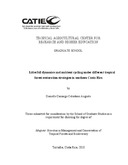| dc.description.abstract | Islas (árboles sembrados en parches de tres tamaños), Control (regeneración natural) y Bosque Secundario joven (7-9 años). Los tratamientos (parcelas de 50 x 50m) fueron establecidos en junio de 2004 en seis sitios en el sur de Costa Rica. Las especies plantadas fueron dos nativas maderables (Terminalia amazonia y Vochysia guatemalensis) intercaladas con dos fijadoras de nitrógeno (Erythrina poeppigiana e Inga edulis.La Producción de hojarasca no difirió (F = 129,4 p <0,0001) entre el bosque secundario (7,3 Mg ha-1 año-1) y la plantación (6,3 Mg ha-1 año-1), mientras que las islas presentan valores intermedios (3,5 Mg ha -1 año-1), y el control (1,4 Mg ha-1 año-1) la Producción más baja. Hojas representaran > 75% de la hojarasca. Inga edulis aportó el 70% de las hojas en las plantaciones. La concentración de Ca, Mg, K, Zn y Mn en la hojarasca fue significativamente mayor en los bosques secundarios que otros tratamientos, y esto se correlacionó positivamente con la mayor diversidad de especies. En consecuencia, las estrategias de restauración que presentan un diseño de plantación más heterogéneos, como el método de islas, pueden promover un incremento más rápido de la diversidad vegetal y la calidad de la hojarasca, y luego acelerar el restablecimiento de los ciclos de nutrientes. En mi proyecto de Maestría, se evaluó la dinámica de la hojarasca y nutrientes bajo cuatro tratamientos:Plantación (toda la superficie plantada) My MONc. project evaluated litterfall and nutrient dynamics under four recovery treatments: plantation (entire area planted), islands (planting in six patches of three sizes), control (natural regeneration), and young secondary forest (7 - 9 yr). Treatments (plots of 50 {D7} 50 m) were established in June 2004 at six replicate sites in southern Costa Rica. Planted species included two native timber-producing hardwoods (Terminalia amazonia and Vochysia guatemalensis)intercropped with two nitrogen-fixing species (Inga edulis and Erythrina poeppigiana). Litterfall production did not differ significantly (F = 129.4, p < 0.0001) between secondary forest (7.3 Mg ha-1 year-1) and plantation (6.3 Mg ha-1 year-1), whereas islands presented intermediate values (3.5 Mg ha-1 year-1), and control (1.4 Mg ha-1 year-1) had the lowest production. Leaves represented >75% of total litterfall. Inga edulis contributed 70% of leaf fall in plantations. Nutrient concentrations for Ca, Mg, K, Zn and Mn were significantly higher in secondary forest than other treatments, and this was correlated positively with higher species diversity.Accordingly, restoration strategies with more heterogeneous planting designs, such as the island methodology, may promote a more rapid increase in plant diversity and litter quality, which could in turn accelerate the reestablishment of nutrient cycling. | es_ES |


